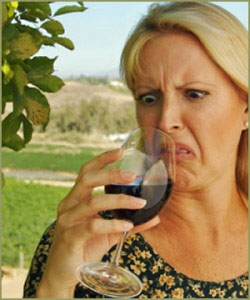VintageTexas Sunday “Cyclopedia of Wine: Wine Faults

I have been doing a lot of blogging on wine quality lately. But, from your perspective as a wine drinker in an evolving wine producing region like Texas (now the fifth largest wine producing state in America), it’s high time to understand some of the basics of what separate bad and just OK Texas wines from well-crafted, premium Texas wines.
In one word, it’s “Faults”.
A wine fault (also called flaw or defect) is an unpleasant characteristic often resulting from poor condition of the grapes, winemaking practices or storage conditions, that leads to grape and/or wine spoilage or contamination.
Since grape growing and winemaking are, in essence, biological processes, many of the compounds that cause wine faults are also naturally present in finished wine, but at concentrations below the usual limits of detectability for the human palate and nose. However, when the concentrations of these compounds increase to critical levels, they replace or obscure the natural fruit flavors and aromas that the wine should express. At this point, the quality of the wine is reduced, making it less appealing and sometimes undrinkable.
One way to get quality wines is to know what some of the common wine fault are and what they impart to the wine tasting experience in terms of off-putting characteristics. Many faults originate from lack of control during grape growing, post-harvest storage and transport, and during winemaking and bottle storage. Common areas of concern are poor hygiene, exposure of the finished wine to oxygen, production or addition of excessive sulfur compounds, the use of poor quality corks, and poor post-production storage of the wine.
Here are a few characteristics that you should to be aware of, and be able to discern while tasting wines, especially our Texas wines. It is particularly important to be aware of these faults in the winery tasting room and at a wine bar or restaurant in advance of purchase. If you become aware of a fault, do not be shy about discussing it with the winemaker or winery representative, or the restaurant barkeep, Sommelier, owner, or by taking the wine back to the store or wine shop and making them aware of the potential problem. This is only way the system gets feedback and can address the problem from its source.
— — — — —
Do you sense the following aromas?

Plastic Band-Aid. You know the smell. It indicates the presence of brettanomyces (Brett for short). It’s a form of microbial growth usually derived from yeast spoilage. In low concentration, it can be a slight barnyard aroma that some refer to as an “old world” wine characteristic. In excess it is a sign of poor cleanliness in the winery.
Sulfur (Burnt Match). Excess of sulfur dioxide. All wines have sulfites, but too much can be unpleasant.
Musty/moldy almost sweet odor (sweaty sox). This is commonly referred to as “corked” and caused by the formation of a chemical called 2-4-6 Trichloroanisole, or TCA. It is usually accompanied by a loss of fruit character of the wine.
Weak fruit character. Results from vineyard that was allowed to hang too much fruit or where it rained just before or during the harvest, so that the juice in the grapes was diluted
Rotten egg smell. The odor of hydrogen sulfide, usually the result from spoilage, contamination and unwanted microbial action.
Smell of cooked fruit, burnt sugar or toffee. It is referred to as maderization acceptable in some dessert wines. In red and white table wines, however, this is a fault where wine becomes oxidized oftentimes exposed to excessive temperatures.
Bottle fermentation/bubbles in still table wines. While some wines are bottled with a carbonation (Frizzante to fully sparkling wines). Otherwise, this carbonation results when unremoved yeast reacts with residual sugar in the wine.
Skunk (You know the smell). This a caused by mercaptans, another set of sulfur compounds, usually caused by yeast spoilage during winemaking.
Vinegar or finger nail polish smells. A sign of acetic acid bacteria, formed when fermentation or barrel storage is not correctly handled. It often starts with the vinegar smell and left to continue can turn into the finger nail polish (ethyl acetate) smell.
— — — — —
Being a good wine consumer is being a critical wine consumer. There is too much good, well-made wine sold in the increasingly global marketplace. Texas is in competition with old-world regions of France, Spain and Italy, and also with new world regions such as California (and the next three wine-producing states), Argentina, Chile, and South Africa to name just a few. You are the point in the system that needs to know the difference between good and flawed wines and your feedback is critical, especially if you find flaws in Texas wines. Our wines need to get better and better, year after year; to do otherwise will lead to failure.
Remember: Life is too short to drink bad wine, especially if it is Texas wine. There are some very good Texas wines out there.

This is very interesting. I don’t think I’ve come across all of those smells, but I have come across some bad wines. This definitely helps me identify what might be wrong the next time I do.